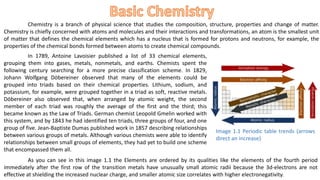Report
Share

Recommended
Recommended
More Related Content
What's hot
What's hot (20)
Timeline of Historical Development of Atoms and Chemical Elements

Timeline of Historical Development of Atoms and Chemical Elements
Historical and Philosophical Foundations of Chemistry

Historical and Philosophical Foundations of Chemistry
Similar to Chemistry
Similar to Chemistry (20)
giorgiana1976 Teacher Doctorate Debater, Expert Since antiquity, aro.pdf

giorgiana1976 Teacher Doctorate Debater, Expert Since antiquity, aro.pdf
Recently uploaded
Recently uploaded (20)
Food safety_Challenges food safety laboratories_.pdf

Food safety_Challenges food safety laboratories_.pdf
HMCS Vancouver Pre-Deployment Brief - May 2024 (Web Version).pptx

HMCS Vancouver Pre-Deployment Brief - May 2024 (Web Version).pptx
ICT role in 21st century education and it's challenges.

ICT role in 21st century education and it's challenges.
Fostering Friendships - Enhancing Social Bonds in the Classroom

Fostering Friendships - Enhancing Social Bonds in the Classroom
Jual Obat Aborsi Hongkong ( Asli No.1 ) 085657271886 Obat Penggugur Kandungan...

Jual Obat Aborsi Hongkong ( Asli No.1 ) 085657271886 Obat Penggugur Kandungan...
UGC NET Paper 1 Mathematical Reasoning & Aptitude.pdf

UGC NET Paper 1 Mathematical Reasoning & Aptitude.pdf
Unit-V; Pricing (Pharma Marketing Management).pptx

Unit-V; Pricing (Pharma Marketing Management).pptx
This PowerPoint helps students to consider the concept of infinity.

This PowerPoint helps students to consider the concept of infinity.
HMCS Max Bernays Pre-Deployment Brief (May 2024).pptx

HMCS Max Bernays Pre-Deployment Brief (May 2024).pptx
Kodo Millet PPT made by Ghanshyam bairwa college of Agriculture kumher bhara...

Kodo Millet PPT made by Ghanshyam bairwa college of Agriculture kumher bhara...
Chemistry
- 1. Chemistry is a branch of physical science that studies the composition, structure, properties and change of matter. Chemistry is chiefly concerned with atoms and molecules and their interactions and transformations, an atom is the smallest unit of matter that defines the chemical elements which has a nucleus that is formed for protons and neutrons, for example, the properties of the chemical bonds formed between atoms to create chemical compounds. As you can see in this image 1.1 the Elements are ordered by its qualities like the elements of the fourth period immediately after the first row of the transition metals have unusually small atomic radii because the 3d-electrons are not effective at shielding the increased nuclear charge, and smaller atomic size correlates with higher electronegativity. In 1789, Antoine Lavoisier published a list of 33 chemical elements, grouping them into gases, metals, nonmetals, and earths. Chemists spent the following century searching for a more precise classification scheme. In 1829, Johann Wolfgang Döbereiner observed that many of the elements could be grouped into triads based on their chemical properties. Lithium, sodium, and potassium, for example, were grouped together in a triad as soft, reactive metals. Döbereiner also observed that, when arranged by atomic weight, the second member of each triad was roughly the average of the first and the third; this became known as the Law of Triads. German chemist Leopold Gmelin worked with this system, and by 1843 he had identified ten triads, three groups of four, and one group of five. Jean-Baptiste Dumas published work in 1857 describing relationships between various groups of metals. Although various chemists were able to identify relationships between small groups of elements, they had yet to build one scheme that encompassed them all. Image 1.1 Periodic table trends (arrows direct an increase)
- 2. 1. The nucleus of an atom consists of A. electrons and neutrons B. electrons and protons C. protons and neutrons D. All of the above 4. The element which has the smallest atomic radius among the following is A. Na B. H C. Hg D. Pb 3. The most electronegative element among the following is A. sodium B. bromine C. fluorine D. oxygen 4. Who was the first chemists in grouping the elements A. Svante Arrhenius B. Max Born C. Amedeo Avogadro D. Antoine Lavoisier
Editor's Notes
- Basic Chemistry
